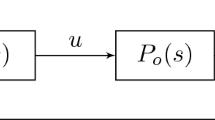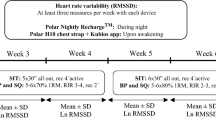Abstract
Purpose
This study was conducted to test, in mountain running route conditions, the accuracy of the Polar V800™ monitor as a suitable device for monitoring the heart rate variability (HRV) of runners.
Method
Eighteen healthy subjects ran a route that included a range of running slopes such as those encountered in trail and ultra-trail races. The comparative study of a V800 and a Holter SEER 12 ECG Recorder™ included the analysis of RR time series and short-term HRV analysis. A correction algorithm was designed to obtain the corrected Polar RR intervals. Six 5-min segments related to different running slopes were considered for each subject.
Results
The correlation between corrected V800 RR intervals and Holter RR intervals was very high (r = 0.99, p < 0.001), and the bias was less than 1 ms. The limits of agreement (LoA) obtained for SDNN and RMSSD were (− 0.25 to 0.32 ms) and (− 0.90 to 1.08 ms), respectively. The effect size (ES) obtained in the time domain HRV parameters was considered small (ES < 0.2). Frequency domain HRV parameters did not differ (p > 0.05) and were well correlated (r ≥ 0.96, p < 0.001).
Conclusion
Narrow limits of agreement, high correlations and small effect size suggest that the Polar V800 is a valid tool for the analysis of heart rate variability in athletes while running high endurance events such as marathon, trail, and ultra-trail races.


Similar content being viewed by others
Abbreviations
- ECG:
-
Electrocardiogram
- ES:
-
Effect size
- GPS:
-
Global positioning system
- HF:
-
Power in the high-frequency band
- HFn:
-
Normalized HF power
- HRM:
-
Heart rate monitors
- HRV:
-
Heart rate variability
- LF:
-
Power in the low-frequency band
- LFn:
-
Normalized LF power
- LF/HF:
-
Low-frequency-to-high-frequency ratio.
- LoA:
-
Limits of agreement
- NN:
-
Normal-to-normal intervals
- pNN50:
-
Proportion of differences between adjacent NN intervals of more than 50 ms
- P :
-
Total power of the spectral density
- RMSSD:
-
Root mean square of differences of successive NN intervals
- SDNN:
-
Standard deviation of all NN intervals
- T(1–6b):
-
Error type 1 to 6b
- VLF:
-
Power in the very low-frequency band
References
Arai Y, Saul JP, Albrecht P et al (1989) Modulation of cardiac autonomic activity during and immediately after exercise. Am J Physiol 256:H132–H141
Aubert A, Seps B, Beckers F (2003) Heart rate variability in athletes. Sports Med 33(12):889–919
Bland JM, Altman DG (2007) Agreement between methods of measurement with multiple observations per individual. J Biopharmaceut Stat 17:571–582
Boardman A, Schlindwein F, Rocha A, Leite A (2002) A study on the optimum order of autoregressive models for heart rate variability. Physiol Meas 23(2):325–336
Broersen P (2000) Finite sample criteria for autoregressive order selection. IEEE Trans Signal Process 48(12):3550–3558
Burg JP (1975) Maximum entropy spectral analysis. Dissertation, Stanford University
Cohen J (1988) Statistical power analysis for the behavioral sciences. Lawrence Eribaum Associates, Hillsdale
Furlan R, Piazza S, Dell’Orto S et al (1993) Early and late effects of exercise and athletic training on neural mechanisms controlling heart rate. Cardiovasc Res 27:482–488
Gamelin FX, Bosquet L, Berthoin S (2006) Validity of the Polar S810 heart rate monitor to measure R–R intervals at rest. Med Sci Sports Exerc 38(5):887–893
Gamelin FX, Baquet G, Berthoin S, Bosquet L (2008) Validity of the Polar S810 to measure R–R intervals in children. Int J Sports Med 29:134–138
Giavarina D (2015) Understanding Bland Altman analysis. Biochem Med 25(2):141–151
Giles D, Draper N, Neil W (2016) Validity of the Polar V800 heart rate monitor to measure RR intervals at rest. Eur J Appl Physiol 116:563–571
Gomis P, Caminal P, Vallverdú M, Warren S, Stein P, Wagner G (2012) Assessment of autonomic control of the heart during transient myocardial ischemia. J Electrocardiol 45(1):82–89
Hynynen E, Uusitalo A, Konttinen N, Rusko H (2006) Heart rate variability during night sleep and after awakening in overtrained athletes. Med Sci Sports Exerc 38(2):313–317
Kingsley M, Lewis M, Marson R (2005) Comparison of Polar 810S and an ambulatory ECG system for RR interval measurement during progressive exercise. Int J Sports Med 26(01/02):39–44
Mainardi L (2009) On the quantification of heart rate variability spectral parameters using time–frequency and time-varying methods. Philos Trans R Soc A 367:255–275
Mateo J, Serrano P, Bailón R et al (2001) Heart rate variability measurements during exercise test may improve the diagnosis of ischemic heart disease. Proc 23rd Ann Int Conf IEEE 503–506
Melia U, Roca E, Brotons et al (2014) Heart rate variability in ultra-trail runners. Comput Cardiol 41:997–1000
Nunan D, Jakovljevic D, Donovan G, Hodges L, Sandercock G, Brodie D (2008) Levels of agreement for RR intervals and short-term heart rate variability obtained from the Polar S810 and an alternative system. Eur J Appl Physiol 103(5):529–537
Nunan D, Donovan G, Jakovljevic D, Hodges L, Sandercock G. Brodie D (2009) Validity and reliability of short-term heart-rate variability from the Polar S810. Med Sci Sports Exerc 41(1):243–250
O’Connor GT, Buring JE, Yusuf S et al (1989) An overview of randomized trials of rehabilitation with exercise after myocardial infarction. Circulation 80:234–244
Pichot V, Roche F, Gaspoz JM et al (2000) Relation between heart rate variability and training load in middle-distance runners. Med Sci Sports Exerc 32(10):1729–1736
Plews D, Laursen P, Stanley J, Kilding A, Buchheit M (2013) Training adaptation and heart rate variability in elite endurance athletes: opening the door to effective monitoring. Sports Med 43(9):773–781
Porto LGG, Junqueira J (2009) Comparison of time-domain short-term heart interval variability analysis using a wrist-worn heart rate monitor and the conventional electrocardiogram. Pacing Clin Electrophysiol 32:43–51
Radespiel-Tröger M, Rauh R, Mahlke C, Gottschalk T, Mück-Weymann M (2003) Agreement of two different methods for measurement of heart rate variability. Clin Auton Res 13(2):99–102
Rocha AP, Almeida R, Leite A, Silva MJ, Silva ME (2014) Long-term HRV in critically ill pediatric patients: coma versus brain death. Comput Cardiol 41:89–92
Ruha A, Sallinen S, Nissila S (1997) A real-time microprocessor QRS detector with a 1-ms timing accuracy for the measurement of ambulatory HRV. IEEE Trans Biomed Eng 44:159–167
Sumi K, Suzuki S, Matsubara M, Ando Y, Kobayashi F (2006) Heart rate variability during high-intensity field exercise in female distance runners. Scand J Med Sci Sports 16(5):314–320
Task Force of the European Society of Cardiology and the North American Society of Pacing and Electrophysiology (1996) Heart rate variability: standards of measurement, physiological interpretation and clinical use. Circulation 93: 1043–1065
Thomas JR, Nelson JK, Silverman SJ (2015) Research methods in physical activity. Human Kinetics Publishers, Champaign
Vanderlei L, Silva R, Pastre C, Azevedo F, Godoy M (2008) Comparison of the Polar S810i monitor and the ECG for the analysis of heart rate variability in the time and frequency domains. Braz J Med Biol Res 41(10):854–859
Voss A, Schroeder R, Vallverdú M, Schulz et al (2013) Short-term vs long-term heart rate variability in ischemic cardiomyopathy risk stratification. Front Physiol 4:364–380
Voss A, Schroeder R, Heitmann A, Peters A, Perz S (2015) Short-term heart rate variability. Influence of gender and age in healthy subjects. PLoS One 10(3):e0118308
Wallén MB, Hasson D, Theorell T, Canlon B, Osika W (2012) Possibilities and limitations of the polar RS800 in measuring heart rate variability at rest. Eur J Appl Physiol 112:1153–1165
Weippert M, Kumar M, Kreuzfeld S, Arndt D, Rieger A, Stoll R (2010) Comparison of three mobile devices for measuring R–R intervals and heart rate variability: Polar S810i, Suunto t6 and an ambulatory ECG system. Eur J Appl Physiol 109(4):779–786
Funding
This work was supported in part within the framework of the Ministerio de Economía, Industria y Competitividad (MINECO) Grant TEC2014–60337–R, the European Union’s Horizon 2020 research and innovation programme under Grant Agreement No. 633196 (CATCH ME), and the Centro de Investigación Biomédica en Red (CIBER) of Bioengineering, Biomaterials and Nanomedicine, an initiative of the Instituto de Salud“ Carlos III” (ISCIII).
Author information
Authors and Affiliations
Contributions
Participated in research design: PC, PG, EG, LM, AP and NS. Conducted experiments: FS and NS. Performed data analysis: PC, PG, AP and FS. Wrote or contributed to the writing of the manuscript: PC, PG, EG, LM, AP, FS and NS.
Corresponding author
Ethics declarations
Informed consent
A group of 22 consecutively recruited volunteers gave their written informed consent to participate in this study.
Ethical approval
The protocol was reviewed and approved by the Healthcare Ethics Committee of the Hospital Clínic of Barcelona (2013/8255).
Conflict of interest
Pere Caminal, Fuensanta Sola, Pedro Gomis, Eduard Guasch, Alexandre Perera, Núria Soriano, and Lluis Mont declare that they have no conflicts of interest.
Additional information
Communicated by Jean-René Lacour.
Electronic supplementary material
Below is the link to the electronic supplementary material.
Rights and permissions
About this article
Cite this article
Caminal, P., Sola, F., Gomis, P. et al. Validity of the Polar V800 monitor for measuring heart rate variability in mountain running route conditions. Eur J Appl Physiol 118, 669–677 (2018). https://doi.org/10.1007/s00421-018-3808-0
Received:
Accepted:
Published:
Issue Date:
DOI: https://doi.org/10.1007/s00421-018-3808-0




